| (insert your NIE or newspaper logo here) |
Weekly Online LessonOnline Lesson ArchiveGrade Level: 7-12
|
The Power of Advertising: Big Tobacco vs. Anti-Smoking Campaigns
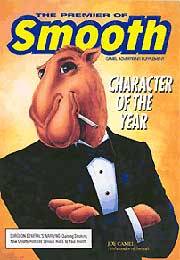 In 1998, the American tobacco industry ended a slew of health-related lawsuits by agreeing to make annual payments to the states worth $246 billion. The settlement also included restrictions on advertising that might attract teenagers. Among these were a ban on billboards and cartoon characters such as R.J. Reynolds' Joe Camel.
In 1998, the American tobacco industry ended a slew of health-related lawsuits by agreeing to make annual payments to the states worth $246 billion. The settlement also included restrictions on advertising that might attract teenagers. Among these were a ban on billboards and cartoon characters such as R.J. Reynolds' Joe Camel.
A similar fear of the tobacco industry's powerful sway over people's decisions to smoke or not to smoke was evident in the global arena last week, when the World Health Organization announced March 1, 2003 that it had adopted a final draft of the international treaty titled, the Framework Convention on Tobacco Control. The draft, approved after four years of negotiations, will be presented at the W.H.O.'s annual conference in May.
Developing countries, like many in Africa, for example, are projected to be the biggest growth areas for tobacco-related illnesses over the next 20 years, and are especially supportive of the proposed treaty. The United States says it will not adopt the treaty in its current form, because some of the stipulations may violate citizens' rights as outlined by the Constitution
 However, if adopted in its current form, the treaty would ban advertising and promotion of tobacco products in countries where that would be constitutional. The tobacco industry would also be required to divulge all the ingredients in cigarettes, print warning labels that cover at least 30 percent of the package, and ban companies from using terms like "ultralight" or "light."
However, if adopted in its current form, the treaty would ban advertising and promotion of tobacco products in countries where that would be constitutional. The tobacco industry would also be required to divulge all the ingredients in cigarettes, print warning labels that cover at least 30 percent of the package, and ban companies from using terms like "ultralight" or "light."
Most people understand that smoking is extremely bad for their health. But, you may ask, if they make that personal choice, despite those warnings, then what's the problem?
The problem is directly related to the tobacco industry's aggressive advertising campaigns. Over the decades, these companies have become experts at selling smoke, especially targeting specific groups of people, like young adults and military personnel. So for this week's lesson, you'll take a critical look at how tobacco companies have marketed their products over the years. You'll also check out the leading anti-smoking campaign's efforts, and compare their tactics in swaying the public's health choices.
The Smoking Gun
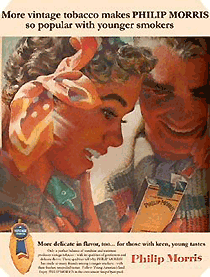 Like any business, tobacco companies need consumers to buy their products to make money. Advertising is what draws attention to their products and provides opportunity to convince consumers that they want, and even "need," to buy those products.
Like any business, tobacco companies need consumers to buy their products to make money. Advertising is what draws attention to their products and provides opportunity to convince consumers that they want, and even "need," to buy those products.
To understand how the advertising power of this industry developed, start at the website, Truth in Advertising. Browse the galleries showing print ads from the 1940's and 1950's. As you review these advertisements, think about how exactly they're trying to sell their products and to what types of people. For example, you'll notice that they use words like, "pleasure" and "reward," and often feature celebrity smokers. You'll also see how strongly they marketed cigarettes to military personnel during World War I.
As you view each ad, can you identify exactly how the words and images presented try to influence consumers to buy their products? Are the marketing strategies based on fact, emotion or psychology? What marketing tactics do you find humorous or misleading?
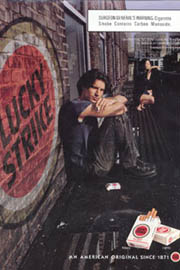 Now check out today's tobacco marketing efforts at the Campaign for Tobacco-Free Kids. Start exploring this website at the Ad Gallery. Here, you can use the pull-down menus at the top to browse by Country, Company, Brand or Ad Type. You'll not only find print advertisements pushing brands of tobacco, but also offers of logo-wear, like hats and t-shirts, youth sponsorships, and in-store displays next to candy racks. How do these efforts compare to those from the 1940's and 1950's? In what ways do you think they might influence kids, young adults and older adults?
Now check out today's tobacco marketing efforts at the Campaign for Tobacco-Free Kids. Start exploring this website at the Ad Gallery. Here, you can use the pull-down menus at the top to browse by Country, Company, Brand or Ad Type. You'll not only find print advertisements pushing brands of tobacco, but also offers of logo-wear, like hats and t-shirts, youth sponsorships, and in-store displays next to candy racks. How do these efforts compare to those from the 1940's and 1950's? In what ways do you think they might influence kids, young adults and older adults?
While you're here, also read the Special Report: Big Tobacco Still Addicting Kids and browse through the related Special Report, Big Tobacco Increased Ads in Youth-Oriented Magazines. What does the tobacco industry say about its advertising campaigns and whom exactly they're targeting? Based on the ads presented at this site, along with ads you've seen in magazines and other publications, who do you think they are targeting and why?
How have tobacco companies shifted their marketing efforts to comply with the 1998 settlement? Do you think their new marketing strategies are just as powerful, more powerful, or weaker for selling their brands? Are these companies marketing their products responsibly and rightfully? Talk with your friends about what they think, as well, and check out the Youth Action section to further the discussion.
The Truth Is Spreading
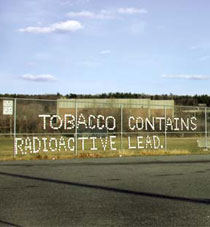 Recently you may have seen television commercials, print or Internet ads from The Truth, currently the most media-savvy anti-smoking campaign. To check out their advertising efforts, enter the HTML or Flash site. (If you explore through the Flash site, just follow the similar topic links as you move through this part of the lesson).
Recently you may have seen television commercials, print or Internet ads from The Truth, currently the most media-savvy anti-smoking campaign. To check out their advertising efforts, enter the HTML or Flash site. (If you explore through the Flash site, just follow the similar topic links as you move through this part of the lesson).
Start by going to the Features section. If you have QuickTime player on your computer, view some of their TV Commercials, Bodybags, Behind the Orange Curtain, and The Memorial clips, or, see some of their images that don't require QuickTime.
Also, stop by the site's Galleries. Check out the Print, Radio (QuickTime required), Web, and additional Television spots they've produced for their campaign. Which ones were the most interesting? Which ones were less compelling?
How do these various marketing strategies combine information, images, emotion and psychology to influence viewers? How does that compare to the marketing efforts of tobacco companies?
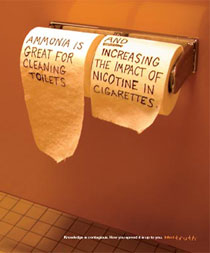 Since tobacco companies aren't allowed to advertise on television, how might the Truth's efforts have a stronger influence on consumers through that medium? Alternatively, since anti-smoking ads aren't typically displayed in stores that sell tobacco products, like convenience marts, how might the tobacco industry's efforts have a stronger influence on consumers through these venues? Do you think either side's efforts actually matter to young adults and others who smoke or don't smoke? Why or why not? If you wanted to convince your friends not to smoke, what strategies would you use and why?
Since tobacco companies aren't allowed to advertise on television, how might the Truth's efforts have a stronger influence on consumers through that medium? Alternatively, since anti-smoking ads aren't typically displayed in stores that sell tobacco products, like convenience marts, how might the tobacco industry's efforts have a stronger influence on consumers through these venues? Do you think either side's efforts actually matter to young adults and others who smoke or don't smoke? Why or why not? If you wanted to convince your friends not to smoke, what strategies would you use and why?
Can you think of other advertised products that aren't very good for your health? Examples may include, high-calorie fast-food items, sugar-packed soda pop, or big SUVs that produce relatively high levels of pollution. In what ways are these products advertised? Do the ads and commercials influence your decisions? If so, how exactly? If not, why not?
Newspaper Activities
Browse a current issue of Targetnewspaper and look for advertisements for products related to lifestyles or health issues. How does the ad use images and words to market the product? Do they evoke any emotions or employ images of success or popularity? What types of consumers do you think each ad is targeting? How well do you think the ad influences people's decisions to buy or not buy those products? How much "fact" does the ad incorporate? Do you notice any differences between advertisements for healthy products and products that are likely to negatively affect a consumer's health?
© Copyright 2002
Learners Online, Inc.
